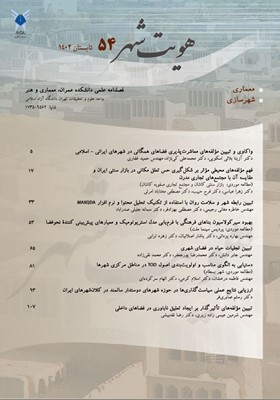فهم مولفه های محیطی مؤثر بر شکلگیری حس تعلق مکانی در بازار سنتی ایران و مقایسه آن با مجتمعهای تجاری مدرن (نمونه موردی بازار سنتی کاشان و مجتمع تجاری صفویه کاشان)
محورهای موضوعی : معماریزهرا عباسی 1 , فرح حبیب 2 * , مصطفی مختاباد 3
1 - دانشآموخته دکتری معماری، گروه معماری، دانشکده هنر و معماری، ، واحد علوم و تحقیقات، دانشگاه آزاد اسلامی، تهران، ایران.
2 - گروه معماری، دانشکده هنر و معماری، واحد علوم و تحقیقات، دانشگاه آزاد اسلامی، تهران، ایران.
3 - گروه پژوهش هنر، دانشکده هنر و معماری، دانشگاه تربیت مدرس، تهران، ایران.
کلید واژه: بازار سنتی ایران, حس مکان, مجتمعهای تجاری مدرن, حس تعلق,
چکیده مقاله :
بازار یکی از عناصر تأثیرگذار در شهرهای تاریخی مسلمانان است. در طول شکلگیری این شهرها، بازارها همواره دارای عملکردهای متعدد اجتماعی، اقتصادی، کالبدی و فرهنگی بودهاند. این مقاله بر آن است تا بامطالعه روی بازار سنتی به ارزیابی نقش فضای معماری در کیفیت محیط بپردازد؛ و اینکه چگونه بازار سنتی ایرانی با در نظر گرفتن فرایند ادراکی به نیازهای انسانی پاسخ داده و منجر به خلق خاطره جمعی و حس تعلق به مکان شده است. لذا شناخت مؤلفههای اثرگذار در القا حس مکان و ارزیابی چگونگی پاسخ فضاهای سنتی و مدرن به نیازهای انسانی، مدنظر تحقیق است تا بتوان با شناسایی عوامل مؤثر به ارتقا کیفیت فضاهای مشابه معاصر کمک کند.با تهیه پرسشنامه و بررسی پیمایشی اطلاعات، جمعآوری و در نرمافزار spss دادهها تجزیهوتحلیل گردید. بر اساس نتایج، وجود مؤلفههای حس مکان در بازار سنتی ایرانی تأیید شد و مدل و پیشنهادهای کاربردی برای فضای مشابه معاصر ارائه گردید.
Bazaar is one of the most influential spaces in the Muslim city. During the formation of towns, bazaar often has multiple social, economic, political and cultural functions. This paper presents a study of traditional market and commercial complex in Kashan, to create a sense of place in environmental quality deals of the environment and its components involved in creating the sense of place. Therefore, factors affecting the sense of place and assess how to respond to the humanitarian needs of the modern and traditional market is intended in this research.Iranian traditional architecture, particularly Bazaar architecture, is a type of visual-perceptual architecture. The architecture which involves all senses includes the body; eyes penetrate in it; skin feels its texture; ears hear its interaction with people and nature; and muscles act and react to experience it. The designers of such environments could also make it possible for people to perceive conceptions and symbolic values. The architecture of Bazaar of Kashan, as one of the examples of Iranian bazaars, creates the sensory concentration system by embodying sensory incentives. In addition to this major system, corridors invite you to walk through them and discover the surroundings and peace can be found in places such as mosques, Timches and open spaces nearby. Based on the human being's perceptual processes in response to his needs, the architecture of Iranian traditional bazaars in the first place promotes psychological health of the society and then considers the connection with meaning. Architects considered all the human perceptual needs by utilizing all his senses and emphasized on cultural and identity issues by mixing religious forms with artistic designs.In the bazaar, perception happens as a result of crowding and privacy in the environment. In the first place, this solitude leads to relaxation, reflection, and afterward to a system of meaning based upon human consciousness which is acquired through his previous experiences and current culture eventually leading to an understanding of the values and aesthetics. In the Iranian bazaar, architects paid attention to all human senses and his perceptual needs and their mixed religious functions with spatial designs in order to emphasize on culture and identity-related issues. As the backbone of cities, Iranian bazaars have had a persistent connection with urban texture, causing such a strong public presence that they were considered the main crossing of the city.It seems that the recreation of a bazaar in the contemporary urban life addressed by architects, planner, and urban planners should be based upon the contemporary human perceptual process. Nowadays, bazaars are losing their value relative to other parts of the city and their economic role has decreased obviously. There have been competitors across the city for bazaars, which were not successful either in the building or strong relationship with clients. The research hypotheses are preparing the necessary information regarding the data collected and analyzed in SPSS software. Accordingly, the results confirmed that the components of sense of place is fully presented in traditional space and more specifically in the traditional bazaar.
_||_

